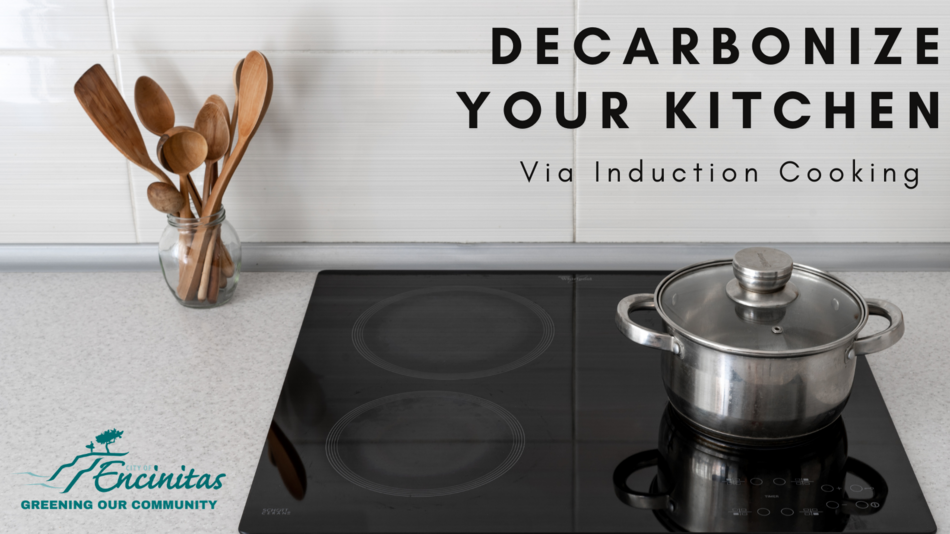The Power of Magnets: Induction Cooking
In the fight against climate change, reducing emissions from buildings has a key role to play. In Encinitas, the electricity and natural gas emissions sectors account for thirty-nine percent of total carbon emissions, second only to transportation in emissions footprint size. These emissions come from heating, cooling, and otherwise powering buildings, and are a key area to target in emissions reduction strategies. While electricity emissions associated with buildings will decrease as the amount of renewably generated electricity supplied to homes and businesses increases, natural gas will experience no such decrease without intervention. Luckily, there are a multitude of ways to reduce natural gas emissions from buildings, including in your own home!
Natural gas-powered water heaters, boilers, stoves, and other appliances are the main contributors to building related gas use, and have effects beyond their contribution to climate change. Natural gas combustion has associated health impacts, which are of particular concern indoors and in poorly ventilated settings. Cooking with a gas stovetop produces harmful air pollutants such as particulate matter, nitrogen oxides, carbon monoxide, and formaldehyde. These pollutants have detrimental health effects, especially when they are highly concentrated indoors, and can present prolonged exposure to residents. Children are especially vulnerable, and cooking with a gas stove has been shown to increase risk of current childhood asthma by 45%.
You can opt for a safer and more environmentally friendly kitchen by switching to an induction cooktop! Induction cooktops use electromagnetism to heat cookware, and can boil water faster than a traditional stovetop.
The Benefits of Induction Cooking
Induction cooking differs from traditional cooktops in that the induction stovetop has an electromagnetic field just below the cooktop surface, directly transferring electric current to the cookware to heat your food. Due to this direct transfer, induction cooking is more efficient and thus able to cook faster than a gas range; induction cooking is also extremely responsive to adjustments in dialing the heat up or down to a specific temperature while cooking. Induction cooking has made major advances in the past decade, distinguishing itself from traditional electric cooktops, which do not use electromagnetic radiation, and instead send an electric current through a metal coil, heating the coil which in turn heats the cooktop surface, which then heats the cookware. Induction cooking cuts out the step of heating the cooktop surface.
Induction cooking also saves on energy use and costs compared to gas stovetops, as induction cooking is more efficient and uses less energy. Additionally, induction cooking will only continue to reduce carbon emissions as the electricity grid becomes cleaner and more renewable! Beyond these savings, induction cooking also has multiple safety and health benefits compared to a gas stovetop. With induction cooking, there is no open flame, no explosion risk, and better indoor air quality. Additionally, as the induction stovetop only heats cookware, not the cooktop itself, there is no risk of accidentally turning the stovetop on without a piece of cookware placed on top, reducing the risk of accidental burns.
Why Isn’t It Mainstream
Induction cooking has been widely adopted in other areas of the world, namely across Europe and Asia. Unfortunately, they have not had the same success in the US, with only 1% of stovetops in the country being induction based as of 2019. This reluctance is partially driven by concern over the types of cookware that are compatible with induction cooktops; only pots and pans with magnetic bottoms (steel or iron) can work with induction stoves. There has also been a widespread lack of education regarding the benefits of induction cooking in the US, similar to the historical adoption of microwave ovens, which suffered slow acceptance through the 1970’s due to a lack of consumer knowledge on how they worked and what benefits they conferred.
Despite the challenges that induction cooktops have faced, they are more affordable and accessible than ever! Portable induction cooktops, in particular, are a great way for consumers to try out induction cooking and reduce their use of natural gas.
Making the Switch
Induction cooktops are a simple switch that create meaningful benefits and change, for both the climate at large and the health of those otherwise exposed to natural gas related indoor air pollution. This switch is helping households and the community as a whole prepare for a resilient future by using electricity, which is cleaner, more affordable, and safer.
If you’re interested in giving induction cooking a try, the San Diego Green Building Council’s Electric Home Cooktop Program is currently loaning out induction cooktops for locals to test out. Details can be found here. SDG&E does not currently provide a rebate for electric cooktops, but further home decarbonization is supported by their Electric Heat Pump Water Heater Rebate. Induction cooktops are sold at a variety of home improvement and appliance stores, so check out the one nearest to you!
If you aren’t currently looking to switch stovetops, even starting the conversation around induction cooking with family and friends is a productive way to bring public awareness to induction as an option and an opportunity!
More information on the City’s decarbonization efforts can be found here.
Previous Post
Clean-Powered Communities
Next Post
How to incorporate sustainability into your child's online and in school learning

